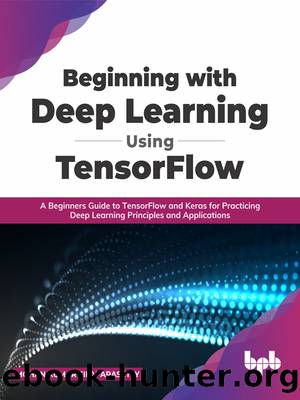Beginning with Deep Learning Using TensorFlow: A Beginners Guide to TensorFlow and Keras for Practicing Deep Learning Principles and Applications by Mohan Kumar Silaparasetty

Author:Mohan Kumar Silaparasetty [Silaparasetty, Mohan Kumar]
Language: eng
Format: epub
Publisher: BPB Publications
Published: 2022-08-15T00:00:00+00:00
Figure 4.57: To display training data=8
Location 2000 has Number 8. In addition to data, MNIST also provides some easy-to-use functions. For example, next_batch takes a number as a parameter and fetches that many images.
This piece of code will fetch randomly selected 100 images from the training data set. It returns the pixel values in batch_x and the labels in batch_y:
Figure 4.58: In built functionânext_batch()
The shape of batch_x is [100, 784], which means there are 100 images in the flattened format of one-dimensional arrays of size 784. The shape of batch_y is [100,10], which means there are 100 one-hot encoded labels in the form of one-dimensional arrays of size 10 with exactly one cell set to 1 and others set to 0.
Let us examine some of the 10 images that are fetched:
Download
This site does not store any files on its server. We only index and link to content provided by other sites. Please contact the content providers to delete copyright contents if any and email us, we'll remove relevant links or contents immediately.
Deep Learning with Python by François Chollet(12863)
Hello! Python by Anthony Briggs(10116)
The Mikado Method by Ola Ellnestam Daniel Brolund(10007)
OCA Java SE 8 Programmer I Certification Guide by Mala Gupta(9977)
Dependency Injection in .NET by Mark Seemann(9512)
Algorithms of the Intelligent Web by Haralambos Marmanis;Dmitry Babenko(8518)
Grails in Action by Glen Smith Peter Ledbrook(7878)
Test-Driven iOS Development with Swift 4 by Dominik Hauser(7848)
The Well-Grounded Java Developer by Benjamin J. Evans Martijn Verburg(7764)
Becoming a Dynamics 365 Finance and Supply Chain Solution Architect by Brent Dawson(7685)
Microservices with Go by Alexander Shuiskov(7442)
Practical Design Patterns for Java Developers by Miroslav Wengner(7367)
Test Automation Engineering Handbook by Manikandan Sambamurthy(7309)
Angular Projects - Third Edition by Aristeidis Bampakos(6729)
Secrets of the JavaScript Ninja by John Resig Bear Bibeault(6629)
The Art of Crafting User Stories by The Art of Crafting User Stories(6226)
NetSuite for Consultants - Second Edition by Peter Ries(6171)
Demystifying Cryptography with OpenSSL 3.0 by Alexei Khlebnikov(5986)
Kotlin in Action by Dmitry Jemerov(5293)
